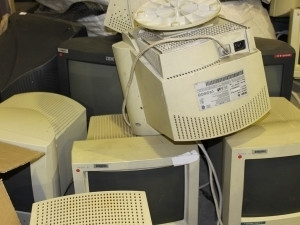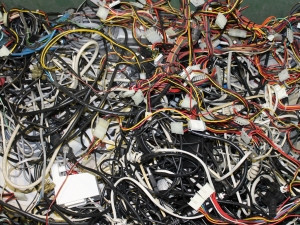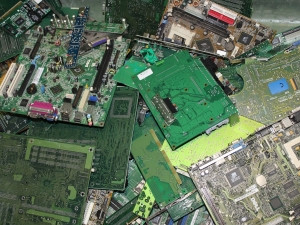
Categories of e-waste
Identification of e-waste categories
1. Large household appliances:
Washing machines, dryers, refrigerators, air conditioners, etc.
2. Small household appliances:
Vacuum cleaners, coffee machines, irons, toasters, etc.
3. Office, information & communication equipment:
PCs, laptops, mobiles, telephones, fax machines, copiers, printers, etc.

4. Entertainment & consumer, electronics and toys, leisure, sports and recreational equipment, and automatic issuing machines:
Televisions, VCR/DVD/DC players, Hi-Fi sets, radios, etc, and electric train sets, coin slot machines, treadmills, etc, and vending machines, parking ticket equipment, etc.
5. Lighting equipment:
Fluorescent tubes and lamps, sodium lamps, etc (except incandescent bulbs, halogen bulbs).
6. Electric and electronic tools:
Drills, electric saws, sewing machines, lawn mowers, etc.
7. Security & healthcare equipment:
Surveillance and control equipment (eg CCTV cameras, scanning equipment), and medical instruments and equipment (eg x-ray and heart-lung machines), etc.
8. Mixed WEEE

Africa e-Waste will collect, refurbish and/or recycle all of the above except lighting equipment.
What is e-waste?
The easiest way to classify e-waste is the following:
Anything that works with electricity or batteries that you no longer need or is no longer working is classified as e-waste.
Please note!

Africa e-Waste collects all types of e-waste from anywhere in South Africa.
The only exception on our collections are lighting equipment.
For the safety of our staff, we do not collect fluorescent tubes, lamps, sodium lamps, etc, or incandescent bulbs or halogen bulbs.
Why should we recover e-waste?
Electronic and electrical waste contains both valuable and potentially hazardous material that can be recovered through proper recycling, while hazardous fractions can be treated prior to safe disposal.
Possible health effects if e-waste is mismanaged
E-waste recycling has direct and indirect effects on human health conditions.
Direct impacts on human health may be caused by:
* Dust in indoor air generated in manual and mechanical dismantling processes (eg when processing plastics or Cathode Ray Tubes (CRTs) found in old TVs and computer screens);
* Filter dust generated in the mechanical dismantling process;
* Noise emissions during the manual and mechanical dismantling process (conveyor belts, hammering, shredders, etc);
* Deviations from occupational safety standards.
Indirect impacts on human health may be caused by:
* Air pollution related to (HT) incineration (however, the situation has been very much improved since waste gas purification systems are a common standard);
* Emissions due to transportation of materials;
* Contamination of water systems and soil near landfills.
The indirect impacts on human health are difficult to quantify among others because of synergistic effects and the time lag between exposure and reaction.
Share